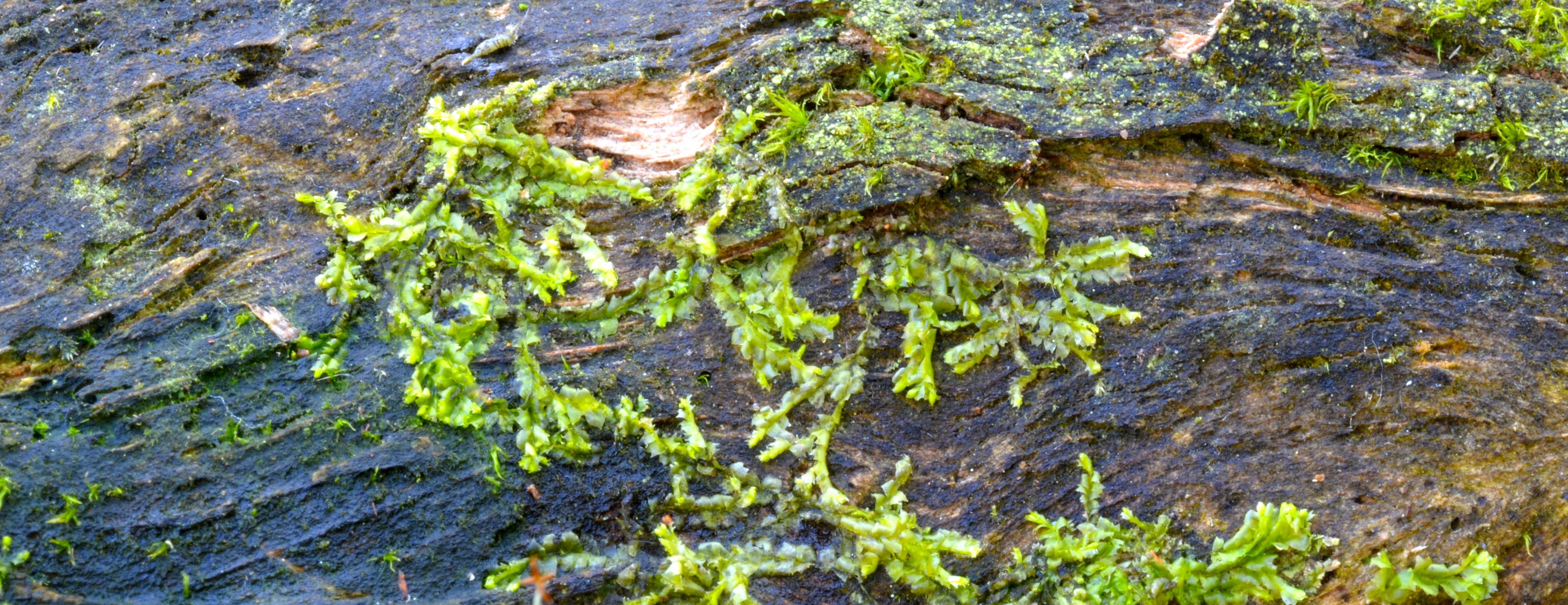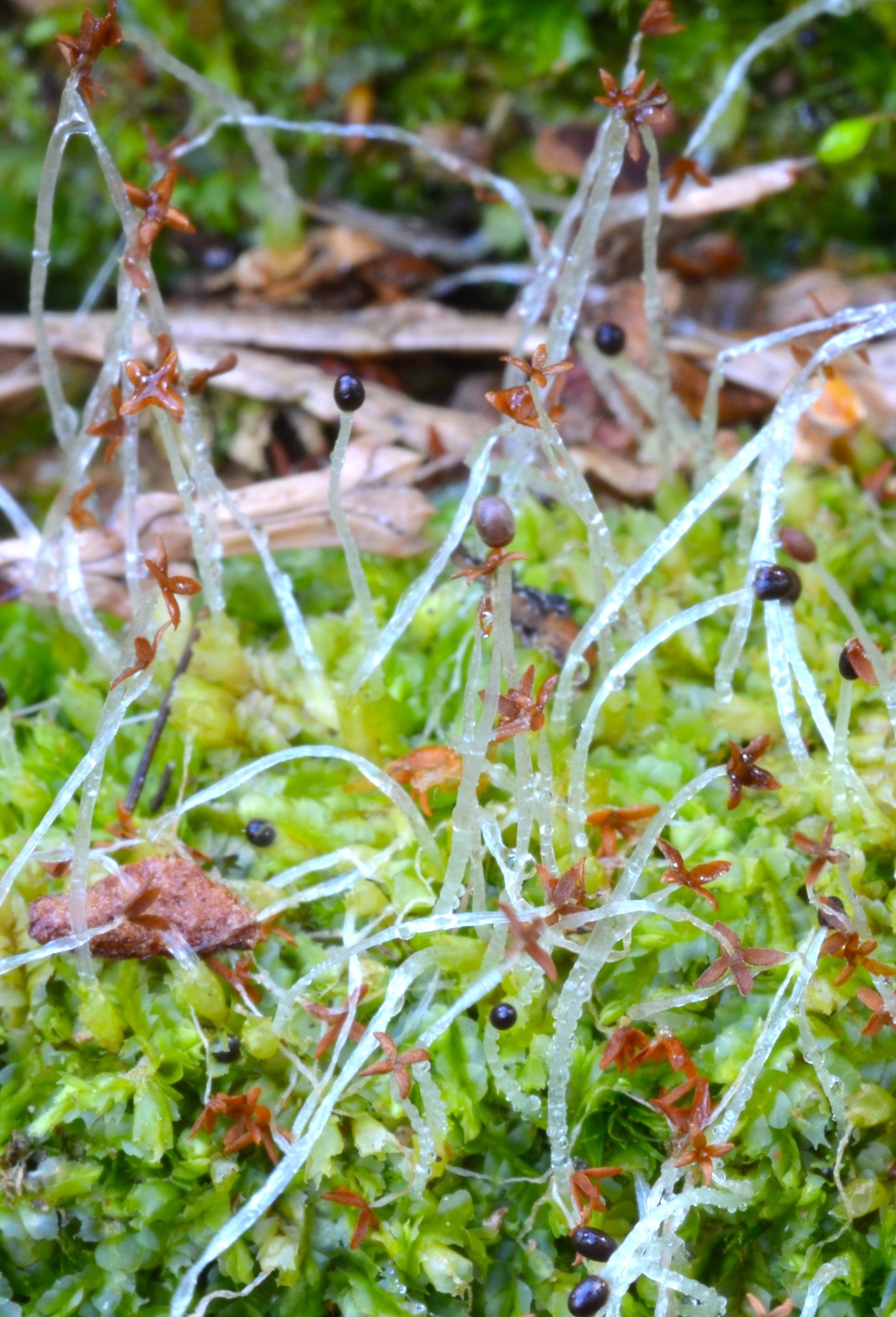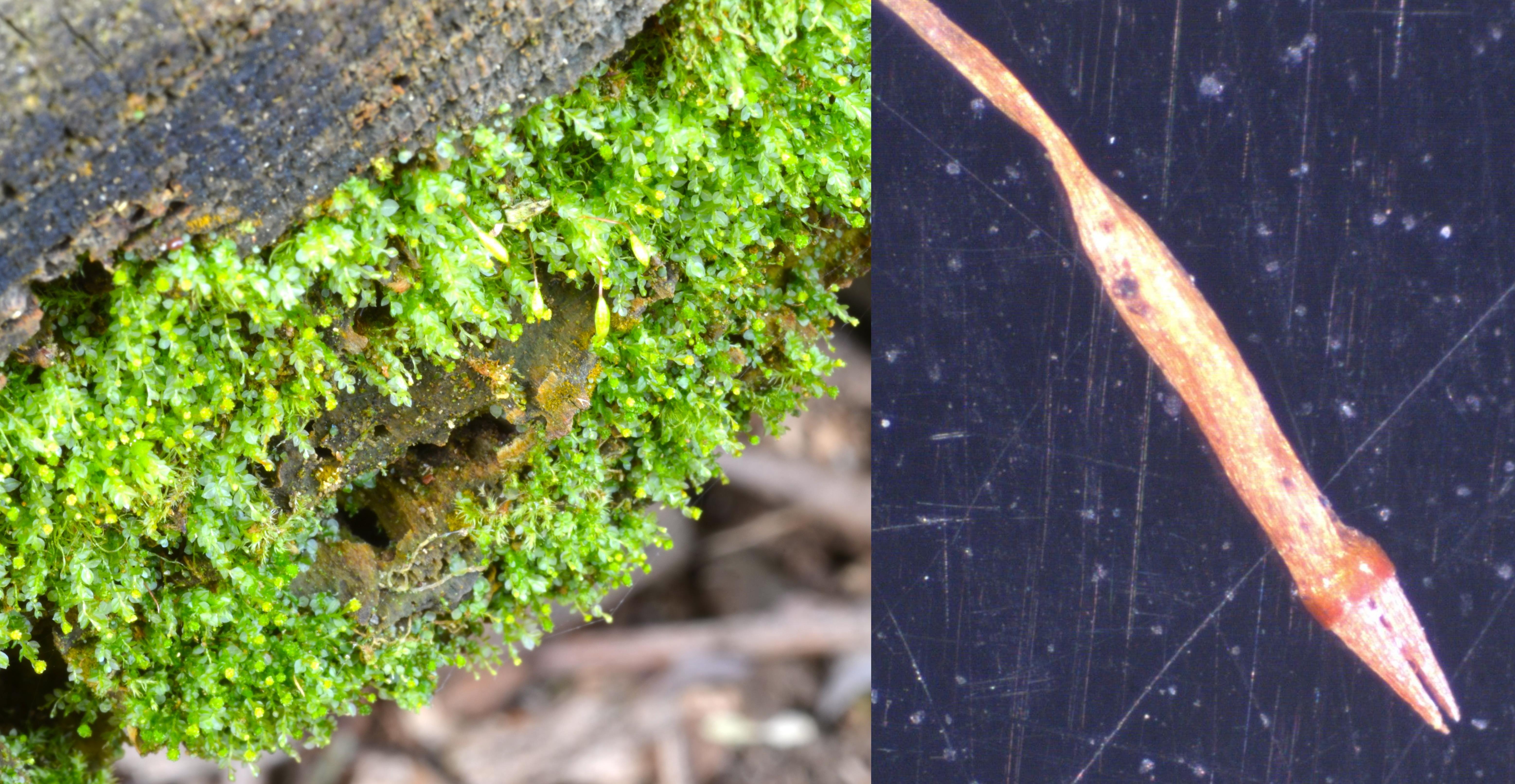
Lophocolea heterophylla, one of the very few liverworts commonly found on decaying wood in south east England. Image by D. Morris
4. Saproxylic Mosses & Liverworts
This is the fifth in a series of posts exploring the mosses and liverworts (bryophytes) of Whiteknights campus. The first three posts described the rich flora of bryophytes growing on trees (epiphytes) on campus, while the second described some of the many species adapted to live on stone (saxicoles). In this post attention is turned to the specialised bryophyte communities that can be found growing on decaying wood on campus (saproxylic, lit. of rotting wood).
Recently fallen trees will retain their bryoflora for some time. Indeed, it is often well worth taking the opportunity to examine fallen branches of large trees for epiphytes. The flora of dead trees does not, however, begin to change until an advanced state of decay has been reached through the action of microscopic organisms and invertebrates. The substrate is by then very acid and water retentive, and can be colonised by a range of bryophytes. These may be very competitive species with a broad ecological tolerance which may have been present on the original tree, or one might find generalists of acid substrates. Of real interest are the species especially adapted to rotting wood.
Compared with higher plants very little is known about the ecology of bryophytes, and it would be very interesting to study the succession of species on decaying wood. Saproxylic species obviously must be very well adapted at dispersal to reach their scattered, ephemeral habitat. Various devices for dispersal are seen in the saproxylic bryophytes present on campus.

Fruiting Lophocolea heterophylla. The seta is very long and pale and bears a spherical black capsule. When ripe this splits by four valves to release the spores, leaving the brown cross-like structures shown. The capsules of mosses never dehisce in this way. Image by D. Morris
In the west of England dead wood can be smothered in liverworts but in the drier east mosses are more common. The only liverwort of dead wood that is anywhere near frequent in this part of the country is Lophocolea heterophylla. Species in this genus of leafy liverworts are easily recognised by their usually strong smell and bright green colouration. L. heterophhylla is very similar to L. bidentata, which is more of a generalist. The leaves of both species bear two sharp teeth with a notch between them: in L. heterophylla this notch becomes shallower toward the stem apex so that the leaves become almost simple (hence hetero-phylla, different leaves), while in L. bidentata the teeth persist. In suitable conditions, both species can form tight bright green mats pressed close against the substrate. Capsules are usually produced abundantly in the spring, and in the form of these one can appreciate one of the principal differences between mosses and liverworts (see image).
Two mosses introduced from the southern hemisphere can be found on rotten wood in the Wilderness. Both species produce abundant capsules and the spores produced have carried these plants all over Britain since their introduction some time in the nineteenth century. Campylopus introflexus is very common and grows abundantly on acidic organic substrates such as decaying wood, or on heathland where it can be a real nuisance. It is easily recognised by its stiffly upright shoots, bright green in the upper half, dark in the lower, with leaves terminating in long colourless hair-points. When dry, the hair-points usually stick out from the shoot to produce a conspicuous starry appearance.

Campylopus introflexus, a very common moss native to the southern hemisphere. The starry appearance of the shoots derives from the hyaline hair-points to the leaves. Image by Michael Becker, via Wikimedia Commons.

The leaves and setae of Orthodontium lineare are characteristically held below the horizontal. Image by D. Morris
Orthodontium lineare is less common on campus and is confined to very well rotten wood, with a curious association with vertical or near-vertical surfaces. The leaves are longly lanceolate and are always curled down below the horizontal. The setae, and therefore the capsules, are also held below the horizontal.
Returning to native species, Tetraphis pellucida is a common moss of decaying wood found throughout the Wilderness. It belongs to a small group of mosses characterised by their four-toothed peristome. Capsules are not usually present in any quantity, but this small moss (2-3mm tall) is easily recognised nonetheless. Leaves are small, round and translucent and at the ends of its upright stems form a broad cup in which sit numerous bright green gemmae. No other moss bears gemmae in this way.

Tetraphis pellucida showing its conspicuous bright-green gemmae (left) and two of the four peristome teeth of the ripe capsule (right). Images by D. Morris
![By Kristian Peters -- Fabelfroh 08:59, 6 December 2006 (UTC) (photographed by myself) [GFDL (http://www.gnu.org/copyleft/fdl.html) or CC-BY-SA-3.0 (http://creativecommons.org/licenses/by-sa/3.0/)], via Wikimedia Commons](https://blogs.reading.ac.uk/whiteknightsbiodiversity/files/2015/04/Aulacomnium_androgynum.jpeg)
Aulacomnium androgynum with its drum-stick-like shoot tips. Image by Kristian Peters via Wikimedia Commons
Aulacomnium androgynum also has gemmae on the tips of its shoots. However, the gemmae are aggregated into balls and the stem below is bare of leaves so that the structure resembles a drumstick. A. androgynum is larger than T. pellucida, and the lanceolate leaves are a dull olive green colour and are seen to be coarsley toothed under a hand lens. A. androgynum grows plentifully on the shaded side of the large uprooted tree in the clearing in the Wilderness.

A mat of Dicranum tauricum on a well-rotted log. Inset: a leaf showing broken-off tip. Images by D. Morris
Dicranum tauricum is also dispersed asexually, but unlike the previous two species it does not possess gemmae. Instead, the tips of its leaves break off and when carried away can germinate to establish new plants. The easiest way to identify this species is to moisten ones finger and run it over the plant: if little green flecks adhere then it is D. tauricum. If one subsequently examines the plant under a lens, shoots will be seen to possess truncated leaves where the tip has broken off.

The distinctively compact tufts of Dicranoweisia cirrata. In the dry state, the leaves are strongly twisted about the shoot. The seta is also yellow and the capsule held erect. Image by D, Morris
Although the broken leaf tips provide a very distinctive character, in its habit and long narrow leaves D. tauricum resembles a number of common mosses found on decaying wood and other acidic substrates, e.g. Orthodontium lineare, Campylopus pyriformis, C. introflexus, Dicranella heteromalla and Dicranoweisia cirrata. The leaves of Dicranum tauricum, however, do not all curve over to one side of the shoot (falcato-secund) as in the first four species (the nerve is also narrow compared with Dicranella and Campylopus spp.). Dicranoweisia cirrata is smaller, forms tighter tufts and the leaves are strongly crisped and wrapped around the stem when dry (like a Ulota); it is also frequently very fertile.

A characteristically pale green mat of Pseudotaxiphyllum elegans. Image by HermannSchachner, via Wikimedia Commons
The final moss to discuss is common on a range of acid substrates in shaded habitats, including rotting wood in the Wilderness. It is interesting for its distinctive growth form. Pseudotaxiphyllum elegans belongs to a small group of pleurocarpous mosses in which the shoots are dorsi-ventrally flattened (or complanate), resembling the fronds of ferns. The plants are a shiny pale green and can form extensive colonies, especially on clayey acid soil banks. It is similar to species of Plagiothecium but is most easily distinguished by the thread like secondary branches borne in the axils of the leaves. These are not always easy to see in the field, but can be present in some quantity. When absent, Pseudotaxiphyllum elegans can be distinguished from a Plagiothecium sp. by the leaves that do not run down onto the stem (i.e. not decurrent), a character best seen by pulling a shoot in half and examining the leaf bases exposed at the severed end.

A shoot of Pseudotaxiphyllum elegans (x50). The flattened appearance is mostly the natural habit of this moss, and not due to its being squashed under a microscope slide. In this family of mosses, the leaves do not possess a strengthening mid-rib. The slender side branches distinctive of this species can be seen in the lower part of the shoot. Image by D. Morris

“… very well adapted at dispersal to reach their scattered, ephemeral habitat …” This actually goes for a lot of organisms where “spores” are almost omnipresent and created in abundnace just to always be in the “right place at the right time” no matter where the opportnunity may arise. After all, no moss or other organism living from decay could know where the next tree would be felled e.g. by lightning so it is quite likely that the living tree already had traces of the later “infestation” which would just not come to “life” until the situation changes and it can take over from the incumbents and overwhelm them in the end. The same omnipresence makes less sense, I should think, for organisms, that live on living organisms, as these do not re-establish themselves from the dead …